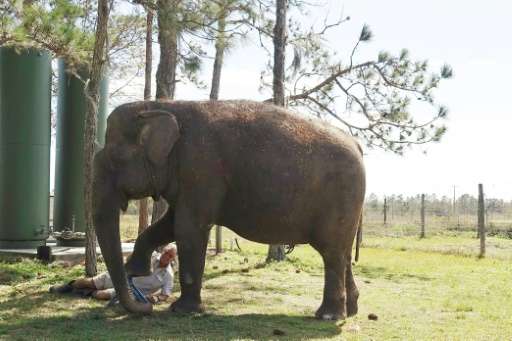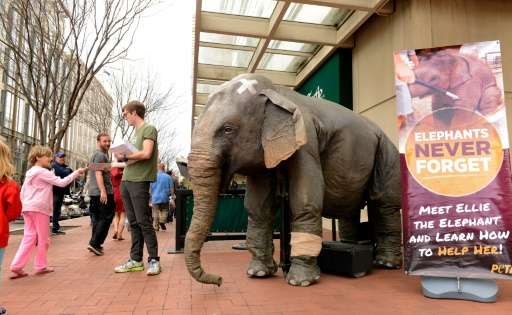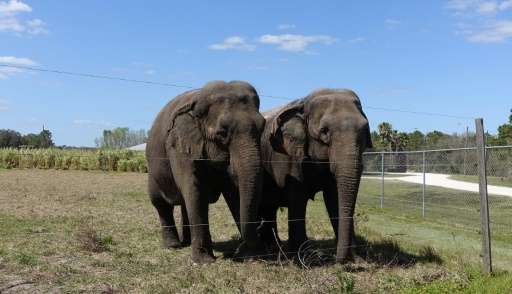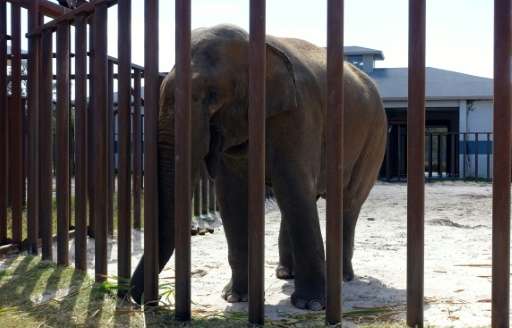Circus elephants' retirement home promises pampered life

When Mysore performed in the Ringling Brothers' traveling circus, she waltzed, she hooked her trunk onto another elephant's tail, and she stood on her hind legs in a line for a trick known as the long mount.
Now at the age of about 70—and one of the oldest Asian elephants in the world—Mysore is retired at the circus's refuge in central Florida, where she gets weekly pedicures, daily baths, naps on a giant dirt pile, eats ground-up hay and more than six loaves of wheat bread a day.
"Boy, she loves the bread," says Janice Aria, the director of animal stewardship at the Ringling Brothers and Barnum and Bailey Center for Elephant Conservation, where Mysore arrived in 2006.
This week, the remaining 11 elephants that traveled in the Ringling Brothers circus will join Mysore and 27 other pachyderms in retirement, ending a 145-year tradition of elephants performing in the circus.
"It is sad. You feel it is the end of an era," says long-time trainer Trudy Williams.
The circus has faced torrents of criticism from animal rights groups, including widely circulated videos from People for the Ethical Treatment of Animals that show a male handler hitting elephants with a pointed-stick, known as an ankus, before a performance.
Ringling Brothers was also embroiled in a 14-year lawsuit in which animal rights groups alleged the circus was mistreating its herd.

The case was eventually thrown out after a lead witness was found to have been paid for his testimony by animal rights groups.
By 2014, the plaintiffs, including the American Society for the Prevention of Cruelty to Animals and the Humane Society, had been ordered to pay the circus $25 million to reimburse its legal fees.
'Outlawed' tool
What finally ended the shows for traveling elephants were the actions of a handful of local municipalities in California, Massachusetts and Virginia that banned circus trainers from using the ankus, a stick about two feet long (0.6 meters) with metal hooks on the end.
Handlers employed by Ringling Brothers maintain that the tool is not used to harm to elephants—which typically weigh 8,000 pounds (3,600 kilograms)—but merely to signal them and give them tactile directions.

"You just don't stand around one of these animals without one of these tools," says Aria.
The logistics of being able to perform with elephants in some cities but not others became too much, Aria says, and the circus announced it would end elephant participation in its shows in 2016, two years earlier than planned.
Retirement life
The Ringling Brothers herd is the largest in the western hemisphere for Asian elephants, listed as an endangered species by the International Union for the Conservation of Nature, which says 40,000-50,000 exist in the world in highly fragmented populations.
The Polk City conservation facility rests on 200 acres (80 hectares) of land in central Florida where orange groves are a common crop.

It opened in 1995 as a place to keep the herd, to breed and raise young ones—26 babies were born here— and to shelter those who simply "never took a shine to circus life," says Aria.
Female elephants are usually paired up and kept in fields that are fenced in with thin electrical wire.
Because of her age, Mysore stays in her own pen.
The males, which like to fight and spar with others, are kept alone behind sturdier bars. Their sperm is collected for breeding purposes, and sometimes a female is put into their enclosure for breeding, or they are sent out to other facilities to mate.
Here, the elephants are fed 2.5 tons of hay daily, and up to 800 pounds of fruit, veggies and greens. They are led into a barn in the afternoon, and chained for the night.

Aria says the elephants are so used to these tethers that they won't relax or eat without them.
But the facility has its critics, and many in the community of people who deal with elephants—from zoos to sanctuaries to researchers of elephants in the wild—are divided about what it means to treat elephants well.
"Their environment needs to stimulate them. That particular piece of property is not an environment that would stimulate an elephant," says Carol Buckley, who was part of a team that inspected the Polk City facility several years ago for the lawsuit.
"It is like a stockyard. It is flat, square, boring," says Buckley, who advocates for female-only elephant sanctuaries in which the animals are not dominated by humans and contact with people is kept to a minimum.
But Ringling Brothers trainer Erik Montgomery says people need to know how to live with elephants.
"The truth of the matter is elephants -– especially Asian elephants—are not going to be around in the future without people's help, without being in responsible, man-managed facilities," he says.
"As long as we can enrich their lives and have a relationship with them—and enrich our own lives in the process—I think that is the way to go."
Mysore—who was born in India and named after a city there before being shipped to the United States in 1947—is a prime example of an elephant living a long and healthy life in the care of humans, Montgomery says.
"Without that human intervention, she wouldn't be here today," he adds.
© 2016 AFP



















